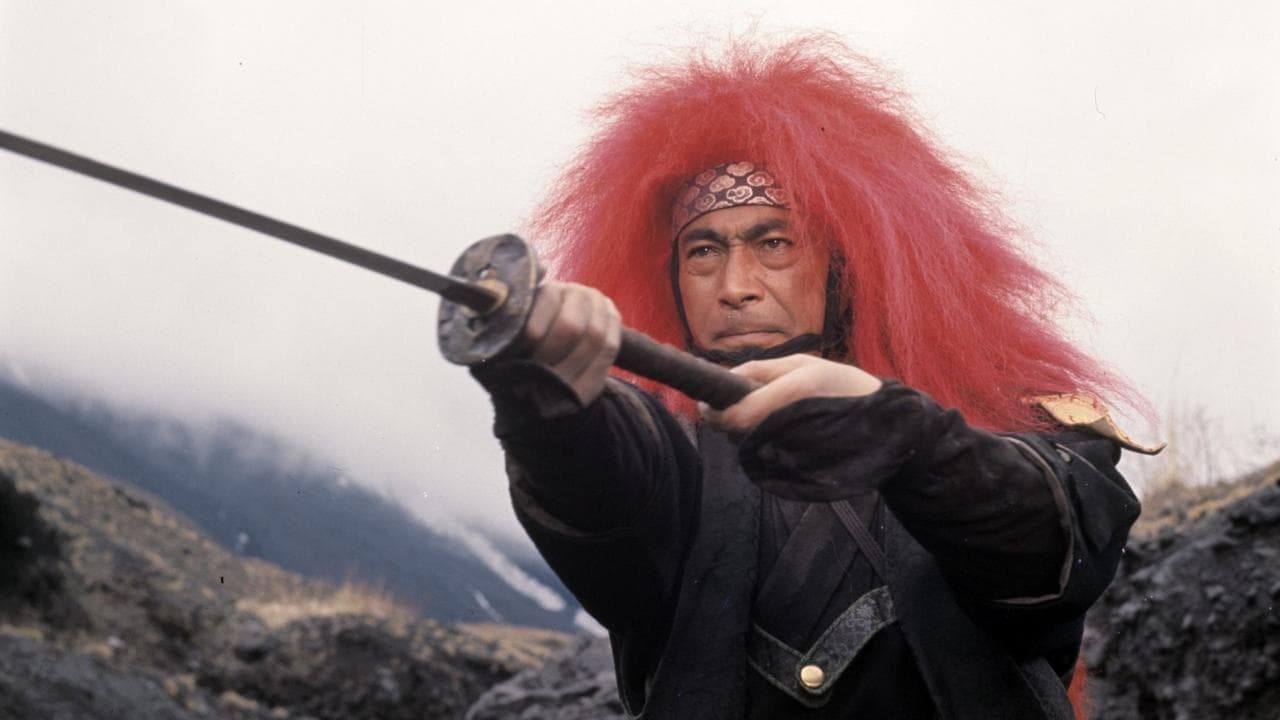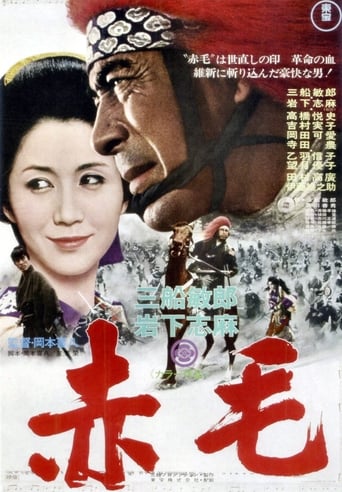

The parallels that run from the jidai-geki and chambara to the spaghetti western and vice versa have been well documented. If Leone's Almeria sagas are Italy's answer to Yojimbo, then Red Lion (Akage) is Japan's answer to the slew of politically orientated spaghetti westerns (usually with the Mexican revolution as the backdrop) that cropped up in Italy around the same time.Toshiro Mifune is Gonzo, a peasant-turned-soldier under the command of the Imperial guard. Being a little familiar with 19th century Japanese history will be make things easier but the movie can still be enjoyed and understood without history lessons. We're witnessing the events that eventually led up to the Meiji Restoration that ended the Shogunate's 400 year reign of Japan and restored the Emperor. Gonzo is with the Imperialists and dreams of a "world changing". He receives the red lion mane by his squad captain and is dispatched to the village he was born in, to convert his compatriots to the Imperialist cause by promising all sorts of social privileges to the lower classes. The village's old higher class (the deputy, a rich merchant) all vehemently oppose Gonzo's promised change and cling as hard as they can to their positions of power. In the meantime, a squad of assassins dispatched in the area by the Shogunate with the purpose of killing an Imperialist general gets involved. Add to that a hired-gun ronin who is paid to kill Gonzo on behalf of the deputy and more twists and turns than you can shake a stick at, and you've got a thoroughly entertaining and interesting movie.Toshiro Mifune starts off as a comedic character only to progress and become a tragic figure and a hero. If Red Lion wasn't so unknown, Gonzo, with his red lion mane, would definitely rank among the genre's icons, next to Sanjuro and Ryunosuke Tsukue. Both his comedic timing (chewing the scenery in ways that might bring Kikuchiyo to mind) and his capacity for drama are amazing. Watching him run the entire gamut of emotions throughout the movie, one feels privileged to see such a great actor at work. Truly one of the best of all time.Kihachi Okamoto is on the director's chair. Not only a distinguished name in the chambara field, but also one of the most skillfull hands to direct action in 60's Japanese cinema. Although Red Lion is not an out and out bloodbath, there are plenty of swordfights to quench your thirst and they're all staged and executed with the flair of a master. Great photography, sets and costumes, all contribute to a very good-looking movie.There's a political and social vein running through Red Lion but it isn't until the final 15 minutes that it becomes a fully fledged political allegory. Like Hanzo, the ronin hired to kill Gonzo, says "the only thing that will change is the flower on the official crest". It soons becomes apparent to the peasants that, Emperor or Shogun, their situation is not going to be much different. This is a power struggle among the big boys and they don't have much care or time for the little guy, apart from trying to recruit him to their cause with all sorts of fake promises. Sounds familiar? Yet Gonzo, if only for three days, manages to change the world. At least for the villagers. For three days it's a peasant's world. Okamoto loves irony and Red Lion is no exception. The red-lion mane that Gonzo wears is the symbol of "the world changing" for him and the people. Not just an emblem of authority, but also of hope. In the end, a betrayed Gonzo realizes it means nothing and throws it on the ground disgusted. The people dance and stomp on it as they push the Imperialist guards out of their village. Simple yet evocative.It's also interesting to point out that the whole revolution of the populi in the end appears to be a marxist concept. But that would be too simple for Okamoto. Echoing Marx's words ("religion is the opium of the masses"), after Gonzo is gunned down by the Imperialist guards, the villagers declare him as "their true god". The irony is so sweet and poignant that it can't be mistaken as unintentional. Perhaps it's Okamoto's way of saying that despite man's attempts to revolt, he always finds himself on the leash of another master, that we only change our cage for a new one. Perhaps not. Perhaps I'm reading too much into it.In the end, as the villagers push the Imperialist guards out of their village, it seems that there's nothing left than this big, loud, colourful carnival. That's life. And Gonzo is the fool, the jester, the tragic figure, the hero who for three days changed the world. Beautiful stuff.All that aside, Red Lion is a funny, dramatic, well staged chambara with enough action and great acting by Mifune. Not to be missed by genre enthusiasts.
... View MoreThis superb movie was my first political science training experience in my youth. I rank it in my top 10 favorite movies. I first saw it (English subtitle was "Red Lion")in its first showing (it was 35 years ago in L.A. or was it S.F.?)as a guest of the local distributer. I'm still affected by it's message of political betrayal. As a fan of T. Mifune, I was already conditioned by his superman samurai image. I kept expecting and then praying that his main character would toss aside his weaknesses and become the champion of justice and vanquish all evil. But, gasp, he doesn't and he is cut down. I still feel the blades in my own body as he is penetrated and dies. There is a lot in this movie but it was this aspect that grabbed me. What a fantastic gift of life instruction from Japan, to be on guard against betrayals in life. I recommend this film to everyone.
... View MoreThis is one of those movies from Japan or China that make me wonder if they are based on some old story. This story is based on a war for on an imperial restoration. I would have to guess the date, but remarkably we see firearms in this movie alongside samurai swords. We see an oafish peasant (Toshiro Mifune) volunteer to soften up his home village because he hears the imperial squad leader announce there will be dramatic reforms.The plot is the story of the peasant and his reception in his home village as he promotes the imperial restoration wearing the honorific red headgear of the imperial squad leader. It's in color and it is a splendid movie, but the story is the real star here. It must be one loved very much by Toshiro Mifune who pulls out all the stops for it.
... View MoreGonzo (Mifune Toshiro), a Robin Hood-like figure, shows up in his home town after several years' absence wearing a red wig like those worn by leaders of the imperial army. The son of a farmer, Gonzo has returned in supposed honor as a leader of the revolutionary imperial army, overthrowing the power of the Tokugawa shogunate and restoring power to the Emperor. Conflict and comedy result as Gonzo's military prowess and connection to the imperial army are called into question. Mifune carries the film in a role similar to his portrayal of Kikuchiyo in Kurosawa's Seven Samurai (1954).Those with little knowledge of the Meiji restoration might find some of the comedy difficult to grasp.I feel that there is an undercurrent of socialist revolution beneath the comedy in this film. The interplay between Gonzo and the local magistrate's samurai bodyguard, Hanzo, is the main vehicle for this agenda. Gonzo displays an unwavering faith that "the world is changing" and that the ruling elite will no longer be allowed to enslave the masses. Hanzo counters him with "the only thing that will change is the flower on the official crest."Okamoto's other films do not necessarily support this agenda, although Samurai Assassin (1965) and Sword of Doom (1966) both center on disillusioned ronin, like Hanzo, who participate in the fractious revolutionary activities leading up to the Meiji restoration out of interest for their personal advancement rather than idealistic belief in social progress.I found this a complex film, but one worth watching if you are interested in Japanese history or culture.
... View More